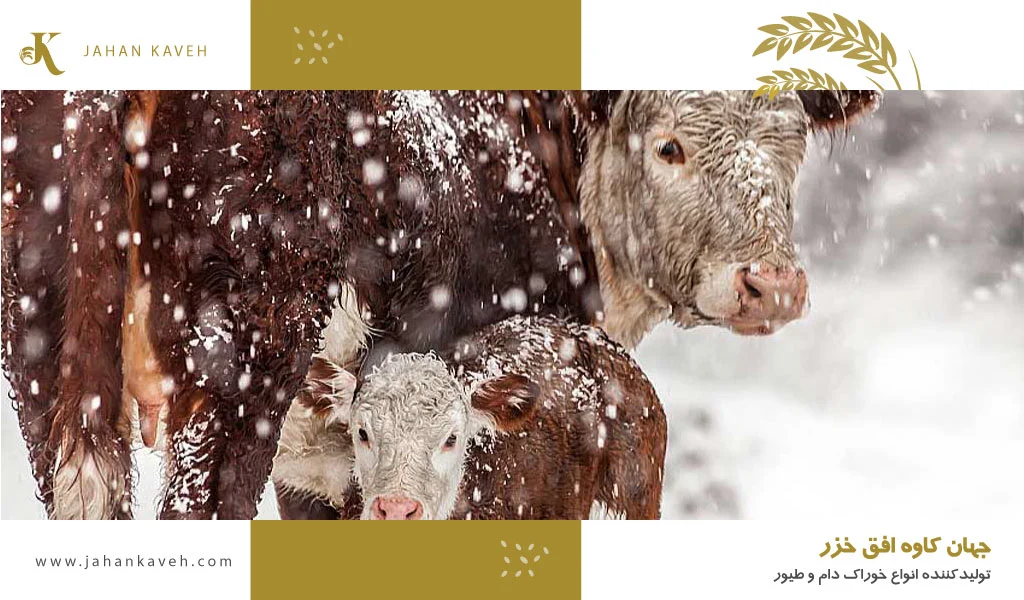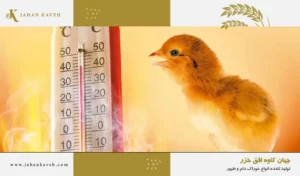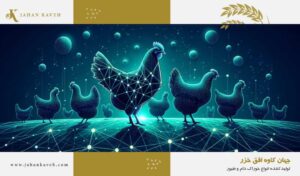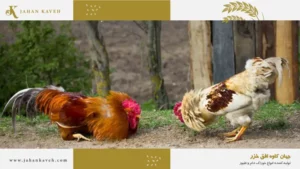Cold stress in livestock
All animals have a thermoneutral zone, which is a temperature range within which the animal is most comfortable and experiences no thermal stress. This is the temperature range that is considered optimal for body maintenance, animal performance, and overall health. The lower boundary of this zone is known as the lower critical temperature (LCT), and when livestock experience temperatures below the LCT, they are considered to be under cold stress.
When livestock experience cold stress below the LCT, their metabolism must increase to generate enough heat to maintain their body temperature. As a general rule of thumb, energy intake should increase by 1% for every degree Celsius below the LCT. This is where the nutritional level of the animal’s diet becomes a critical factor.
Signs of cold stress in cattle
Cold stress can manifest in various forms and can be generally difficult to detect. Some of the telltale signs of cold stress in cattle include:
- Behavioral changes: Cattle may exhibit signs of lethargy, reduced activity, and huddling together for warmth.
- Decreased water intake: Cold-stressed cattle may consume less water, which can lead to dehydration and further complications.
- Reduced milk production: In dairy cows, cold stress can significantly impact milk yield.
- Loss of body condition: Cold stress can increase the animal’s energy demands, leading to weight loss and a decline in body condition score.
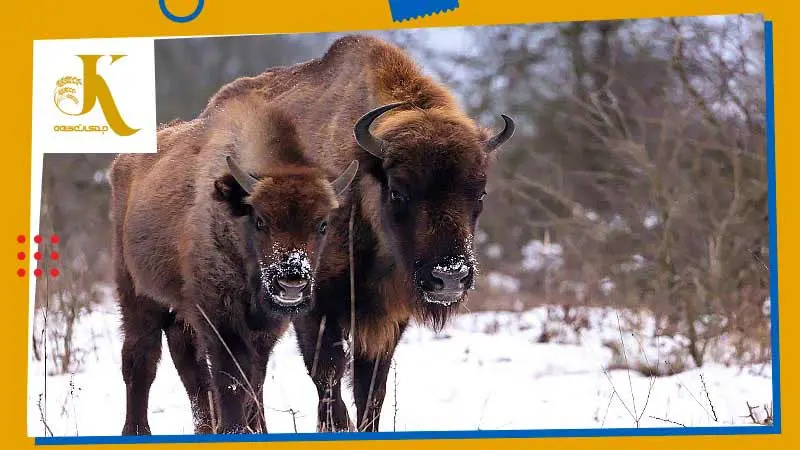
The Importance of Winter Feeding for Livestock
The colder months of the year, particularly fall and winter, can have a significant negative impact on livestock farming and animal health (cattle, sheep, etc.). As mentioned earlier, during these seasons, animals require more food to generate energy and increase their resistance to cold in order to maintain their body temperature. One of the primary challenges in cold regions is the scarcity of pastures and forage for grazing, leading to a shortage of food resources for livestock farmers. Another concern is the prevalence of various livestock diseases during the cold season. In general, the consequences of neglecting proper winter feeding for livestock can include:
- Malnutrition: Nutrient deficiencies can arise from inadequate food intake, leading to various health problems.
- Weight Loss: Animals may experience weight loss, weakening their overall health and reducing their productive capacity.
- Reduced Milk Production: Cold stress and malnutrition can significantly impact milk yield in dairy cows.
- Increased Disease: A weakened immune system can make animals more susceptible to various diseases.
- Reproductive Issues: Breeding and calving rates may decline due to the negative effects of cold stress and malnutrition.
- Increased Risk of Miscarriage: Cold stress and nutritional deficiencies can increase the likelihood of miscarriage, leading to economic losses for livestock famers.
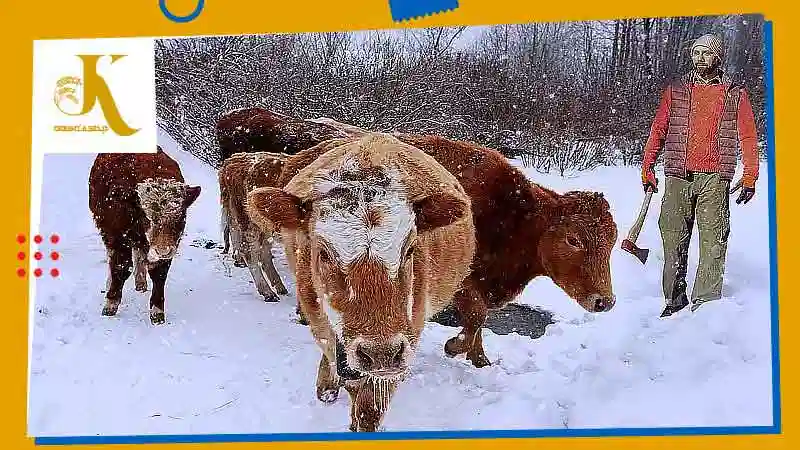
Winter Feeding Dos and Don'ts: A Practical Guide for Livestock Farmers
Some farmers may assume that a 100% increase in energy intake is necessary for their animals to maintain normal body temperature and function during winter. However, according to Susan Kerr, Extension Director of Klickitat County at Washington State University, this sudden and short-term surge in energy intake can be detrimental to most animals. Kerr emphasizes in her book “Winter Livestock Management” that “all dietary changes, whether increases or decreases, should be made gradually.”
Although increasing the energy content of the diet is necessary in adverse weather conditions, livestock are better able to cope with these conditions if they have an appropriate body condition during such times. Kerr notes: “Livestock managers score the body condition of their animals based on the subcutaneous fat content (Body Condition Score).”
A crucial factor in determining the ability of livestock to withstand the rigors of winter is their body condition score (BCS), also known as fat cover or body reserves. Animals entering winter with an adequate BCS (around 3 to 3.5) are far better equipped to navigate this challenging period compared to their leaner counterparts.
To assess an animal’s BCS, a systematic approach called body condition scoring (BCS) is employed. This method scientifically measures the amount of subcutaneous fat in various body regions (such as the back, neck, and tail) and assigns a score between 1 and 5.
Livestock with Adequate BCS:
Animals with a satisfactory BCS in autumn (around 3 to 3.5) can generally survive winter with minimal adjustments to their feed intake. In these cases, forage intake can be reduced from 4.5 to 9 kilograms per day to a minimum of 1.75 to 2.25 kilograms, complemented by sufficient grains. It is crucial to note that further reductions in forage can interfere with normal rumen function. During the winter feeding period, these animals may experience a weight loss of up to 55 kilograms.
Livestock with Inadequate BCS:
Animals entering winter with an unsatisfactory BCS (below 2.5) require more attention and nutritional support. Due to their depleted fat reserves, these animals demand significantly more feed to maintain body temperature and provide energy during the cold months.
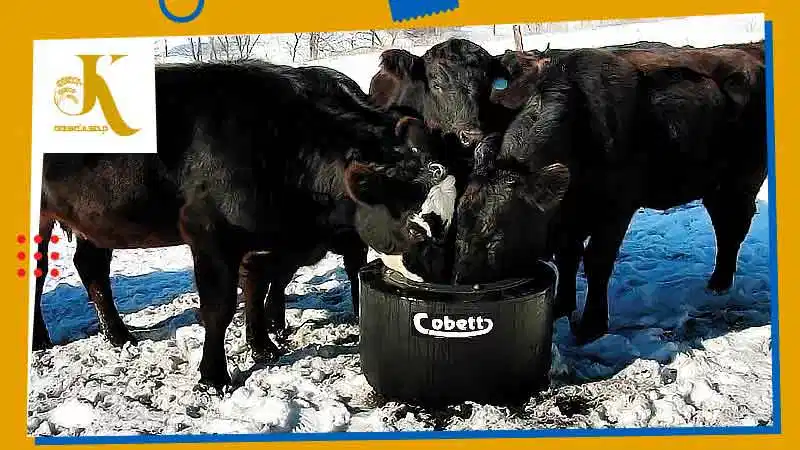
Nutrition during Pregnancy and Lactation
Proper and adequate nutrition during pregnancy and lactation is of paramount importance. Pregnant animals require increased nutrients and energy to ensure a healthy pregnancy and deliver strong, healthy offspring. Lactating cows also need supplementary feed after calving to produce sufficient milk and quickly return to breeding condition. Lactating cows should be able to consume up to twice the energy and protein required before calving. Excessive weight loss can jeopardize their health and lead to breeding problems.
Nutritional Needs of Livestock in Winter:
Ensuring the well-being of their animals is a top priority for every livestock farmer. Proper nutrition plays a crucial role in maintaining animal health, preventing diseases, and optimizing productivity. As winter approaches and lush pastures become scarce, manual feeding becomes essential to provide the necessary nutrients for livestock.
Feeding Frequency and Timing:
- Two Meals per Day: It is generally recommended to feed livestock twice a day during winter to ensure they receive a steady supply of energy and nutrients.
- Emphasis on Evening Feeding: A larger portion of the daily feed should be provided in the evening, as the colder temperatures, especially during the night, increase the animal’s energy demand for heat production in the rumen (digestive system).
Essential Nutrients for Winter Feeding:
Beyond the frequency and timing of feeding, the specific nutritional needs of livestock in winter must be carefully considered. Here’s a breakdown of the key nutrients required:
- Water
- Protein
- Fats or Lipids
- Carbohydrates or Sugars
- Vitamins
- Minerals
By understanding the nutritional needs of livestock in winter and implementing appropriate feeding practices, farmers can effectively maintain animal health, productivity, and profitability throughout the colder months. Proper nutrition is a key investment in the long-term success of any livestock operation.
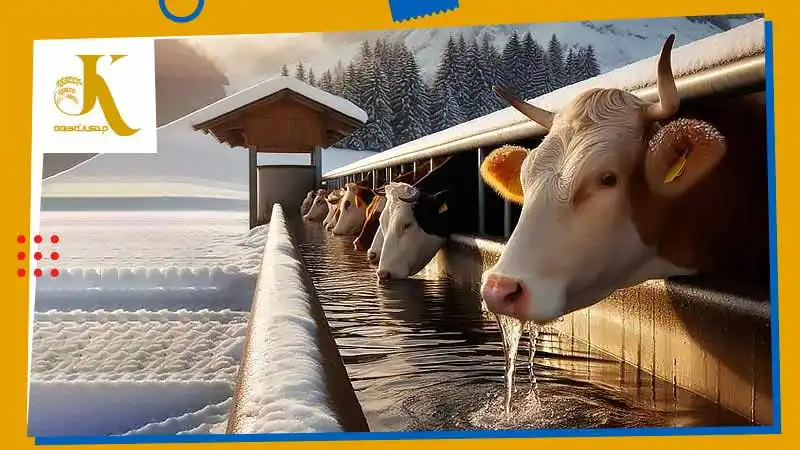
Importance of Maintaining Water Access
Water is an essential component of livestock nutrition, playing a crucial role in various bodily functions, including digestion, nutrient absorption, and waste removal. However, during the winter months, water availability and access can pose challenges for livestock farmers due to freezing temperatures and limited water sources.
Ensuring consistent access to unfrozen water is critical for livestock health and productivity. Dehydration can lead to a range of issues, including reduced feed intake, decreased milk production, and impaired immune function.
Consuming ice can be harmful to livestock, as it expends energy without providing adequate hydration and can lead to digestive problems. Also, Cold water can deter animals from drinking, leading to reduced feed intake and potential weight loss.
Measures to Ensure Water Availability:
- Heating Water Sources: Utilize appropriate heating devices, such as electric or propane heaters, to maintain water temperatures above freezing, especially in outdoor water troughs and tanks.
Insulating Water Sources: Insulate water tanks and pipes to minimize heat loss and prevent freezing. - Strategic Placement of Water Sources: Place water troughs and tanks in sheltered areas, away from direct wind and drafts, to reduce the likelihood of freezing.
- Regularly Checking Water Sources: Regularly check water sources for ice formation and break up any ice that may have accumulated.
Water Requirements for Different Livestock:
- Dairy Cows: High-producing dairy cows require a significant amount of water to support their milk production. A cow producing 30 liters of milk on a silage-based diet may need 75-90 liters (16-20 gallons) of water per day.
- Beef Cattle and Feedlot Animals: Beef cattle and feedlot animals, especially those on high-grain diets, have a high demand for water. They should have constant access to water, with an estimated daily requirement of 60 liters (13 gallons) for every 10 kilograms of dry matter intake.
- Sheep: Sheep’s water intake can be influenced by factors such as diet, environmental conditions, and individual animal characteristics. However, it is generally recommended to provide sheep with constant access to fresh, clean water.
Managing Sudden Water Access:
- Gradual Reintroduction: If livestock have been subjected to water restrictions, reintroduce water gradually to prevent them from drinking excessive amounts and potentially experiencing water intoxication.
- Monitoring Water Intake: Monitor livestock’s water intake closely, especially after periods of water restriction, to ensure they are rehydrating adequately without overconsuming.
By understanding the importance of water access for livestock in winter and implementing appropriate measures to ensure a consistent supply of unfrozen water, farmers can safeguard animal health, productivity, and overall well-being throughout the colder months. Access to clean, fresh water is an essential element of responsible livestock management.
Additional Tips:
Consult a Veterinarian or Animal Nutritionist: Seek guidance from a veterinarian or animal nutritionist to determine the specific water requirements for your livestock based on their breed, age, production status, and environmental conditions.
- Monitor Water Quality: Regularly test water sources for contaminants and ensure they meet the quality standards for livestock drinking water.
- Maintain Water System Hygiene: Keep water troughs and tanks clean and free of debris to prevent the spread of diseases.
- Provide Shade for Water Sources: Ensure water troughs and tanks are shaded during hot periods to prevent overheating of the water.
By following these comprehensive guidelines, livestock farmers can effectively manage water availability and ensure their animals remain hydrated and healthy throughout the year.
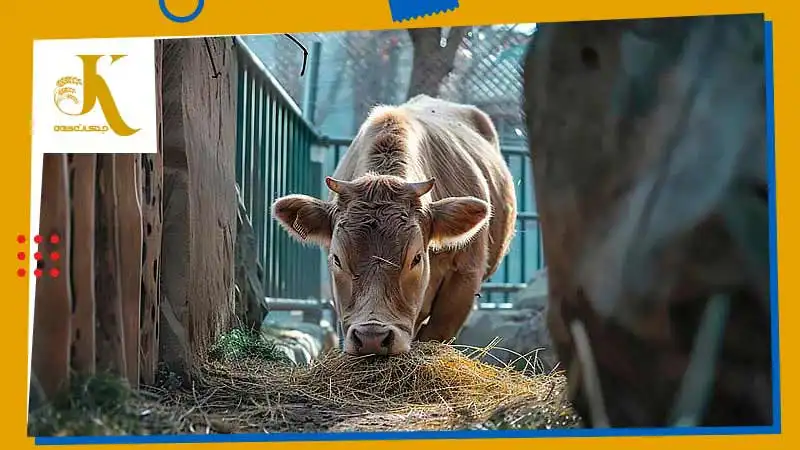
The Impact of Protein on Livestock Diets in Winter
The protein requirement varies depending on the type of animal being fed (bull, calf, or heifer), the stage of life (weaning, maintenance, finishing), and the forage provided (alfalfa, silage, or straw). Always balance the protein content of concentrates with the protein content of forage. It is advisable to use low-volume, high-protein feeds as much as possible. This is particularly important for pregnant livestock. Alfalfa and oilseed meal are among the most important protein sources for animals. Protein deficiency in livestock leads to reduced wool and fiber growth (in animals such as sheep), muscle development, and reproduction. When purchasing livestock feed, be sure to pay attention to the grain or protein content for the animals. You can even use dietary supplements if necessary.
The Impact of Fat or Lipid in Livestock Diet -The Importance of Fat in Winter Diets
Maintaining the required fat level in livestock diets is particularly crucial during winter. By providing the right amount of fat from suitable sources, livestock producers can ensure their animals’ health, productivity, and profitability. Numerous food sources contain fats that provide the necessary energy for the animal’s body. Additionally, fats aid in the absorption of vitamins. Fat plays a significant role in livestock diets by offering various benefits, including:
- Energy Source: Fats serve as a concentrated source of energy, providing approximately 2.5 times more energy per gram than carbohydrates. This is particularly important during winter when energy demands are higher due to colder temperatures and reduced grazing opportunities.
- Improved Nutrient Absorption: Fats enhance the absorption of fat-soluble vitamins, such as vitamins A, D, E, and K, which are essential for various bodily functions.
- Reduced Heat Loss: Fats provide insulation and help maintain body temperature, which is crucial for livestock during cold weather.
- Enhanced Skin and Coat Condition: Fats contribute to healthy skin and coat, which are essential for protection against harsh winter elements.
The Impact of Sugars and Carbohydrates on Livestock Diets
Sugars and carbohydrates play a vital role in livestock nutrition, providing the primary source of energy for various bodily functions, including muscle movement, heat production, and milk production. Understanding the different types of sugars and carbohydrates and their effects on livestock is essential for formulating balanced and effective diets. Types of Sugars and Carbohydrates:
- Monosaccharides: Glucose, fructose, and galactose are examples of monosaccharides, the simplest form of sugars, which are readily absorbed and utilized for energy.
- Disaccharides: Sucrose (table sugar) and lactose (milk sugar) are examples of disaccharides, composed of two linked monosaccharides.
Complex Carbohydrates:
- Starch: Found in grains and legumes, starch is a complex carbohydrate that serves as a primary energy source for livestock.
- Fibers: Non-digestible fibers, such as cellulose and hemicellulose, provide structural support for plants and play a crucial role in rumen function and digestive health.
Impact on Energy Supply:
- Readily Available Energy: Sugars and simple carbohydrates provide a quick and readily available source of energy for livestock, particularly during periods of high energy demand.
- Sustained Energy Release: Complex carbohydrates, like starch, are digested more slowly, providing a more sustained release of energy over time.
Impact on Milk Production:
- Precursors for Milk Lactose: Sugars, particularly glucose, are essential precursors for lactose, the primary sugar found in milk. Adequate carbohydrate intake is crucial for supporting milk production in dairy cows.
- Balancing Sugars and Carbohydrates: Matching Energy Demands: Provide an appropriate balance of sugars and complex carbohydrates to meet the energy demands of the animal, considering factors like age, production status, and environmental conditions.
- Maintaining Rumen Health: Avoid excessive sugar intake, as it can disrupt rumen function and lead to digestive issues. Ensure a balance of soluble and insoluble fibers to promote healthy rumen microbial activity.
Sugars and carbohydrates are essential components of livestock diets, providing energy for various bodily functions and supporting milk production. By understanding the different types of sugars and carbohydrates and their effects on livestock, farmers can formulate balanced and effective diets that optimize animal health, productivity, and overall well-being.
The Impact of Vitamins on Livestock Diets - Essential Vitamins for Livestock
Ensure your livestock receives the necessary vitamins to maintain their health and productivity. Vitamins play a crucial role in the growth and development of young animals. Provide young animals with adequate vitamin intake to support their rapid growth and prevent deficiencies. Vitamin deficiencies can lead to a range of issues, including:
- Blindness: Vitamin A deficiency can cause night blindness and even complete blindness.
- eproductive Problems: Vitamin E deficiency can impair fertility and increase the risk of abortions.
- Musculoskeletal Issues: Vitamin D deficiency can lead to bone deformities and rickets.
Additional Considerations:
- Body Condition and Vitamin Stores: Thinner and younger animals may have lower vitamin reserves. Consider providing them with additional feed to support their vitamin needs.
- Separate Feeding: Separate thinner and younger animals from the rest of the herd to ensure they receive adequate nutrition.
The Impact of Minerals on Livestock Diets - Essential Minerals for Livestock
Minerals are essential for various bodily functions in livestock, including:
- Bone Health: Calcium, phosphoru and magnesium are crucial for maintaining strong bones and teeth.
- Muscle Function: Sodium, potassium, and chloride play a role in muscle contraction and nerve function.
- Immune System: Zinc, copper, and selenium support the immune system and fight off infections.
Mineral deficiencies can lead to a range of health problems, including:
- Reduced Growth and Development
- Weakened Immune System
- Reproductive Issues
- Bone and Muscle Problems
Finally, Evaluate the mineral content of the forage being fed and supplement accordingly to ensure adequate mineral intake. Also, Soil conditions can influence the mineral content of forage. Test your soil regularly to identify potential mineral deficiencies. By ensuring your livestock receives the necessary vitamins and minerals through their diet or supplementation, you can safeguard their health, productivity, and overall well-being.
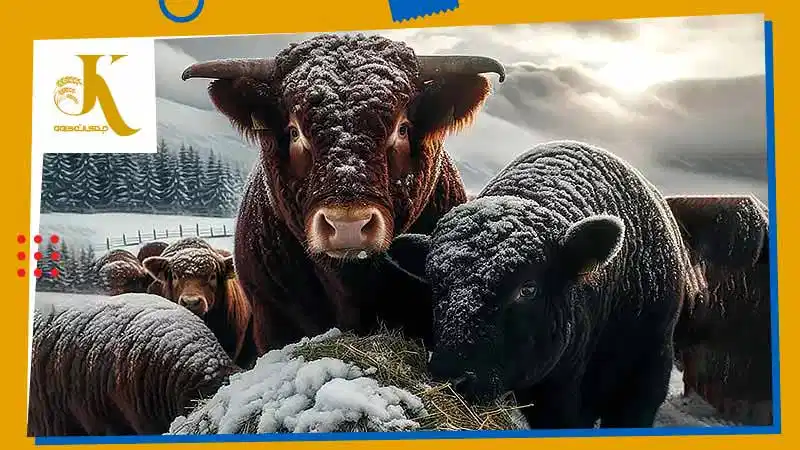
Winter Feed Management for Cattle
A winter feeding management plan helps cattle producers make the most of their forage resources. Understanding the herd’s feed requirements allows producers to make informed herd management decisions that maximize productivity.
Evaluating feed reserves allows cattle producers to determine if they have a potential feed shortage during the cold months. When evaluating feedstuffs, consider what types of hay, silage, alfalfa, and concentrates are available. Be sure to assess the quality of the feedstuffs as well. Sampling hay and analyzing it for nutritional quality can help producers better match the nutritional needs of the cattle with supplements.
By knowing the exact number of cattle, their body condition scores, and the amount of dry matter each animal requires, producers can prioritize feeding. Young calves, heifers, etc., need high-quality feed to gain weight. Mature cows will need lower-quality forage in mid-pregnancy and medium-quality forage in late pregnancy.
Professors James Neel and Warren Gill, University of Tennessee, suggest classifying the herd into different production classes. This allows for groups to be fed according to the specific nutritional needs of each group, improving feed efficiency.
By implementing a comprehensive winter feeding management plan, cattle producers can optimize herd health, productivity, and profitability throughout the cold months.
Livestock Product Purchase: Fattening Feed Concentrate – Cattle and Sheep Concentrate
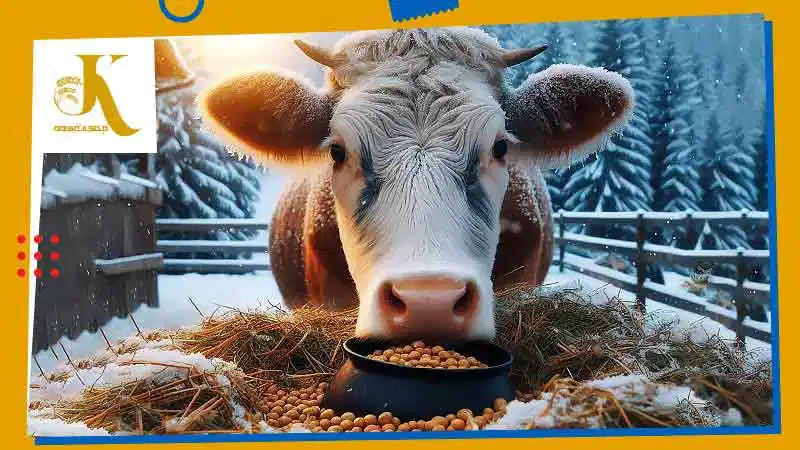
Winter Feed Concentrate Supplement for Livestock
Any discussion of winter concentrate feeding levels should take place within the overall context of the production system. Labor, equipment, and other costs all play a significant role in determining the final profit margin. Therefore, the production system should be designed to minimize these costs as much as possible. In this context, the animal’s diet, which accounts for 70% of production costs, should also be designed to reduce costs.
Another important consideration in winter and cold seasons is the shortage of forage or forage with good nutritional value. Livestock concentrates provide nutrients that forage alone cannot provide. This is especially true for high-producing animals. Concentrates contain different nutrients depending on the type of livestock. Concentrates used for dairy cows are different from those used for fattening cattle. These concentrates help your livestock stay strong and less susceptible to disease. The healthier the livestock, the better the growth and ultimately the better the profitability for the farmer.
Buy Livestock Product: Dairy Cattle Concentrate
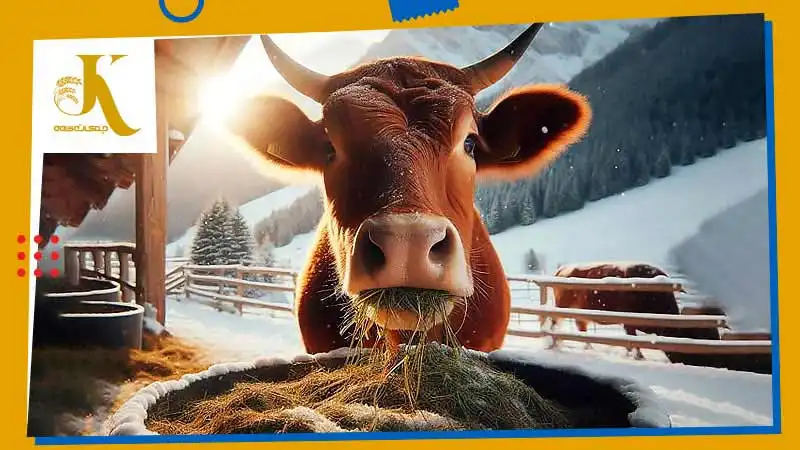
What to Feed Cows in Cold Weather
The heat generated from digestion is an excellent way to keep cows warm. This is why cows consume more food in the winter. During this time, the most important factor to monitor is the amount of protein that reaches the cow. Ideally, protein should be around 10% or higher.
If the protein content of the forage meets this standard and sufficient forage is available, there is no need for protein supplementation alongside the provision of minerals. Adding minerals ensures that the cows receive what they need and also helps the rumen microbes.
However, when the forage quality is below 10% protein, cows may need supplemental protein to help feed the rumen microbes and aid in digestion.
Ultimately, you can do the best for your cows by limiting forage and creating a balanced diet. Byproducts, gluten feed, distillers’ grains, and corn silage are all excellent sources of nutrition and energy to maintain cows. Especially in drought and forage shortage conditions, a high-energy diet can make a difference.
Where to Buy High-Quality Cattle Feed that Meets the Nutritional Needs of Cows
You can find the ingredients of the feed on the packaging or on the product pages. Additionally, Jahan Kaveh Company with over 15 years of experience in producing and selling animal feed, has placed the analysis of all its concentrated feeds on its product page. This company, which operates in Iran and the UAE (Dubai), uses high-quality materials such as Brazilian corn in the production of its concentrates. The company also holds HACCP and GMP certificates, which are not held by many companies.
HACCP stands for Hazard Analysis and Critical Control Points. This standard is a food safety management system that analyzes the biological, chemical, and physical hazards involved in the preparation, production, handling, and consumption of food products. It also provides ways to control these hazards.
On the other hand, the GMP certificate refers to Good Manufacturing Practices. This certificate was developed by the US Food and Drug Administration under federal law for sensitive industries such as pharmaceuticals, food, and cosmetics. The rules and regulations set out in the GMP standard require manufacturers to follow certain guidelines when preparing and packaging drugs, medical devices, and food to ensure their safety and wholesomeness.
The acquisition of these two certificates is a testament to Jahan Kaveh Ofogh Khazar Company commitment to food safety regulations, giving consumers the assurance that the company’s livestock and poultry feed is safe and wholesome.
Refrence:

